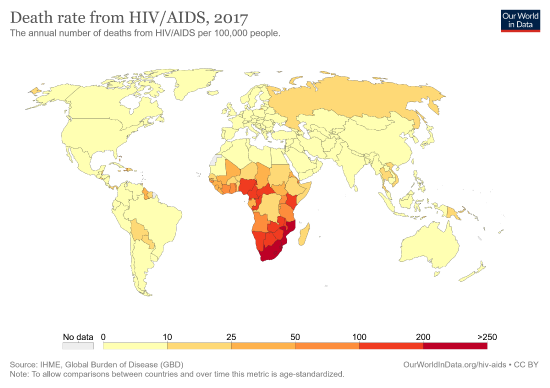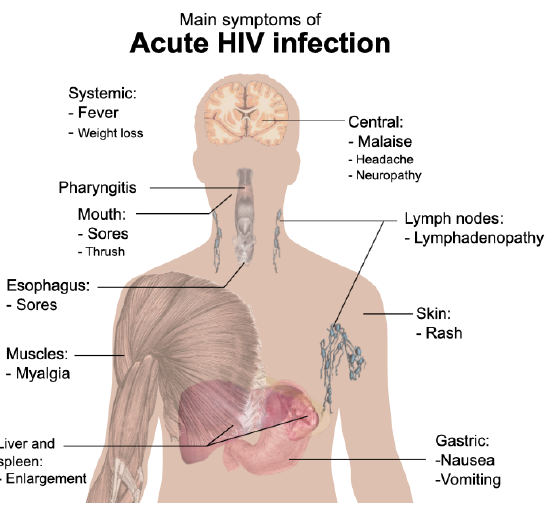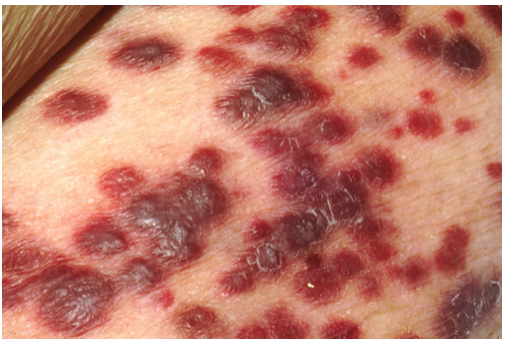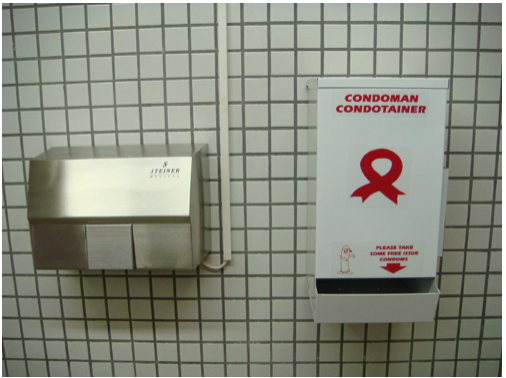21.5: HIV and AIDS
- Page ID
- 17748
\( \newcommand{\vecs}[1]{\overset { \scriptstyle \rightharpoonup} {\mathbf{#1}} } \)
\( \newcommand{\vecd}[1]{\overset{-\!-\!\rightharpoonup}{\vphantom{a}\smash {#1}}} \)
\( \newcommand{\dsum}{\displaystyle\sum\limits} \)
\( \newcommand{\dint}{\displaystyle\int\limits} \)
\( \newcommand{\dlim}{\displaystyle\lim\limits} \)
\( \newcommand{\id}{\mathrm{id}}\) \( \newcommand{\Span}{\mathrm{span}}\)
( \newcommand{\kernel}{\mathrm{null}\,}\) \( \newcommand{\range}{\mathrm{range}\,}\)
\( \newcommand{\RealPart}{\mathrm{Re}}\) \( \newcommand{\ImaginaryPart}{\mathrm{Im}}\)
\( \newcommand{\Argument}{\mathrm{Arg}}\) \( \newcommand{\norm}[1]{\| #1 \|}\)
\( \newcommand{\inner}[2]{\langle #1, #2 \rangle}\)
\( \newcommand{\Span}{\mathrm{span}}\)
\( \newcommand{\id}{\mathrm{id}}\)
\( \newcommand{\Span}{\mathrm{span}}\)
\( \newcommand{\kernel}{\mathrm{null}\,}\)
\( \newcommand{\range}{\mathrm{range}\,}\)
\( \newcommand{\RealPart}{\mathrm{Re}}\)
\( \newcommand{\ImaginaryPart}{\mathrm{Im}}\)
\( \newcommand{\Argument}{\mathrm{Arg}}\)
\( \newcommand{\norm}[1]{\| #1 \|}\)
\( \newcommand{\inner}[2]{\langle #1, #2 \rangle}\)
\( \newcommand{\Span}{\mathrm{span}}\) \( \newcommand{\AA}{\unicode[.8,0]{x212B}}\)
\( \newcommand{\vectorA}[1]{\vec{#1}} % arrow\)
\( \newcommand{\vectorAt}[1]{\vec{\text{#1}}} % arrow\)
\( \newcommand{\vectorB}[1]{\overset { \scriptstyle \rightharpoonup} {\mathbf{#1}} } \)
\( \newcommand{\vectorC}[1]{\textbf{#1}} \)
\( \newcommand{\vectorD}[1]{\overrightarrow{#1}} \)
\( \newcommand{\vectorDt}[1]{\overrightarrow{\text{#1}}} \)
\( \newcommand{\vectE}[1]{\overset{-\!-\!\rightharpoonup}{\vphantom{a}\smash{\mathbf {#1}}}} \)
\( \newcommand{\vecs}[1]{\overset { \scriptstyle \rightharpoonup} {\mathbf{#1}} } \)
\( \newcommand{\vecd}[1]{\overset{-\!-\!\rightharpoonup}{\vphantom{a}\smash {#1}}} \)
\(\newcommand{\avec}{\mathbf a}\) \(\newcommand{\bvec}{\mathbf b}\) \(\newcommand{\cvec}{\mathbf c}\) \(\newcommand{\dvec}{\mathbf d}\) \(\newcommand{\dtil}{\widetilde{\mathbf d}}\) \(\newcommand{\evec}{\mathbf e}\) \(\newcommand{\fvec}{\mathbf f}\) \(\newcommand{\nvec}{\mathbf n}\) \(\newcommand{\pvec}{\mathbf p}\) \(\newcommand{\qvec}{\mathbf q}\) \(\newcommand{\svec}{\mathbf s}\) \(\newcommand{\tvec}{\mathbf t}\) \(\newcommand{\uvec}{\mathbf u}\) \(\newcommand{\vvec}{\mathbf v}\) \(\newcommand{\wvec}{\mathbf w}\) \(\newcommand{\xvec}{\mathbf x}\) \(\newcommand{\yvec}{\mathbf y}\) \(\newcommand{\zvec}{\mathbf z}\) \(\newcommand{\rvec}{\mathbf r}\) \(\newcommand{\mvec}{\mathbf m}\) \(\newcommand{\zerovec}{\mathbf 0}\) \(\newcommand{\onevec}{\mathbf 1}\) \(\newcommand{\real}{\mathbb R}\) \(\newcommand{\twovec}[2]{\left[\begin{array}{r}#1 \\ #2 \end{array}\right]}\) \(\newcommand{\ctwovec}[2]{\left[\begin{array}{c}#1 \\ #2 \end{array}\right]}\) \(\newcommand{\threevec}[3]{\left[\begin{array}{r}#1 \\ #2 \\ #3 \end{array}\right]}\) \(\newcommand{\cthreevec}[3]{\left[\begin{array}{c}#1 \\ #2 \\ #3 \end{array}\right]}\) \(\newcommand{\fourvec}[4]{\left[\begin{array}{r}#1 \\ #2 \\ #3 \\ #4 \end{array}\right]}\) \(\newcommand{\cfourvec}[4]{\left[\begin{array}{c}#1 \\ #2 \\ #3 \\ #4 \end{array}\right]}\) \(\newcommand{\fivevec}[5]{\left[\begin{array}{r}#1 \\ #2 \\ #3 \\ #4 \\ #5 \\ \end{array}\right]}\) \(\newcommand{\cfivevec}[5]{\left[\begin{array}{c}#1 \\ #2 \\ #3 \\ #4 \\ #5 \\ \end{array}\right]}\) \(\newcommand{\mattwo}[4]{\left[\begin{array}{rr}#1 \amp #2 \\ #3 \amp #4 \\ \end{array}\right]}\) \(\newcommand{\laspan}[1]{\text{Span}\{#1\}}\) \(\newcommand{\bcal}{\cal B}\) \(\newcommand{\ccal}{\cal C}\) \(\newcommand{\scal}{\cal S}\) \(\newcommand{\wcal}{\cal W}\) \(\newcommand{\ecal}{\cal E}\) \(\newcommand{\coords}[2]{\left\{#1\right\}_{#2}}\) \(\newcommand{\gray}[1]{\color{gray}{#1}}\) \(\newcommand{\lgray}[1]{\color{lightgray}{#1}}\) \(\newcommand{\rank}{\operatorname{rank}}\) \(\newcommand{\row}{\text{Row}}\) \(\newcommand{\col}{\text{Col}}\) \(\renewcommand{\row}{\text{Row}}\) \(\newcommand{\nul}{\text{Nul}}\) \(\newcommand{\var}{\text{Var}}\) \(\newcommand{\corr}{\text{corr}}\) \(\newcommand{\len}[1]{\left|#1\right|}\) \(\newcommand{\bbar}{\overline{\bvec}}\) \(\newcommand{\bhat}{\widehat{\bvec}}\) \(\newcommand{\bperp}{\bvec^\perp}\) \(\newcommand{\xhat}{\widehat{\xvec}}\) \(\newcommand{\vhat}{\widehat{\vvec}}\) \(\newcommand{\uhat}{\widehat{\uvec}}\) \(\newcommand{\what}{\widehat{\wvec}}\) \(\newcommand{\Sighat}{\widehat{\Sigma}}\) \(\newcommand{\lt}{<}\) \(\newcommand{\gt}{>}\) \(\newcommand{\amp}{&}\) \(\definecolor{fillinmathshade}{gray}{0.9}\)There are many misconceptions about HIV and AIDS. Knowing the realities is important to help prevent the spread of HIV and reduce the stigma associated with it.
Myth: HIV can be transmitted through nonsexual contacts such as kissing, sharing a glass, spitting, sitting on a public toilet seat, and coughing or sneezing.
Reality: HIV has not been shown to be transmissible through such contacts. People can safely interact and have casual contact with HIV-infected individuals without fear of acquiring the virus.
Myth: HIV can be acquired through an act of anal intercourse between two men, regardless of the HIV status of the sexual partners. In other words, homosexual acts in and of themselves increase the risk of acquiring HIV.
Reality: HIV infections can be acquired through sexual contact only with people who are infected with the virus. Uninfected individuals cannot transmit the virus. Homosexual contact is not necessary for the virus to be spread. In fact, most transmissions of HIV occur through heterosexual contacts.
Myth: HIV/AIDS was created by scientists, either accidentally or deliberately.
Reality: This conspiracy theory was created and spread by Operation INFEKTION, a Soviet KGB disinformation campaign. It purposely spread the misinformation that the United States invented HIV/AIDS as part of a biological weapons research project. The Soviet Union spread the now-discredited theory in order to undermine the United States’ credibility, foster anti-American attitudes, isolate America abroad, and create tensions between host countries and the U.S. over the presence of American military bases (which were often portrayed as the cause of AIDS outbreaks in local populations).
Introduction to HIV and AIDS
AIDS stands for acquired immunodeficiency syndrome. It is a disease caused by infection with the human immunodeficiency virus or HIV. HIV is a sexually transmitted virus that infects and destroys helper T cells of the human immune system (see the concept Disorders of the Immune System to learn more about how HIV infects immune system cells). AIDS eventually develops in most people with untreated HIV infections, usually several years after the initial infection with the virus. AIDS is diagnosed when the immune system has been weakened to the point that it can no longer fight off diseases that do not occur in healthy individuals.
Figure \(\PageIndex{1}\) shows the global distribution of deaths due to HIV and AIDS in 2017. The rate ranges from 0 to 250 deaths per 100,000 individuals. Most of those with HIV infections live in sub-Saharan Africa. This is partly due to the fact that this is where HIV first originated as a human disease when the virus jumped from nonhuman primate populations to human populations. Almost one million (954,000) people died from HIV/AIDS in 2017. HIV infections and AIDS are considered to be pandemic — a disease outbreak that is present in multiple populations around the world.

Transmission of HIV
HIV is considered to be a sexually transmitted infection (STI) because that is its most common mode of transmission. However, unlike some other pathogens that cause STIs, HIV is also commonly transmitted through nonsexual contact with HIV-contaminated blood and from HIV-infected mothers to their children.
Sexual Transmission
The majority of all HIV transmissions worldwide occur through sexual contact. Of these cases, most are the result of heterosexual contact. However, the pattern of transmission varies geographically. In the United States, HIV is transmitted more often in men who have sex with men. The risk of transmission from anal intercourse is especially high, whereas the risk of transmission from oral sex is relatively low.
The risk of HIV transmission increases when people are already infected with other sexually transmitted infections, and especially when they have open sores on their genitals. In fact, the presence of genital sores increases the risk of transmission by about fivefold. The risk of transmission is also greater during the early months of infection when infected people usually have the greatest viral load. Viral load refers to the amount of virus in a sample of an infected individual’s blood.
Transmission Through Contaminated Blood
The second most frequent mode of HIV transmission is via contaminated blood and blood products. Blood-borne transmission can occur through needle sharing during intravenous drug use, needle-stick injury in health professionals, transfusion of contaminated blood or blood products, or medical injections with unsterilized equipment. Theoretically, giving or receiving tattoos or piercings can also transmit HIV, but no confirmed cases have been documented. It is not possible for mosquitoes or other blood-sucking insects to transmit HIV.
In 2009 in the United States, intravenous drug users made up 12 percent of all new cases of HIV, and in some areas, more than 80 percent of people who injected drugs were infected with HIV. In rich nations, the risk of acquiring HIV from a blood transfusion is now virtually nil because of careful screening of blood donors and blood products. In poor nations, on the other hand, screening is less rigorous; therefore, rates of transmission through contaminated blood are higher. Unsafe medical injections and invasive medical procedures are also a significant mode of transmission in poor nations, particularly in sub-Saharan Africa. While it is possible to acquire HIV from the infected organ or tissue transplantation, this is rare because of screening.

Mother-to-Child Transmission
The third most common way HIV is transmitted worldwide is from an untreated mother to her child during pregnancy, childbirth, or breastfeeding. If the mother is infected with HIV, there is about a 15% chance that the virus will be transmitted to her infant through her breast milk. The transmission of pathogens from one generation to the next in these ways is called vertical transmission. This mode of transmission accounts for most cases of HIV infection in children.
Stages of HIV Infection
HIV is a type of virus called a retrovirus. Retroviruses are single-stranded RNA viruses that live as parasites inside host cells. HIV primarily infects helper T cells (CD4+ T cells) as well as some other cells of the human immune system. It spreads from helper T cells to helper T cells and causes illness by killing off the helper T cells.
Acute HIV Infection
After HIV enters the human body, there is a period of rapid viral replication, causing a high viral load in the person’s blood and a drop in the number of circulating helper T cells. This stage of infection is called acute HIV infection. It produces an immune system response, in which the number of killer T cells increases. The killer T cells start killing HIV-infected cells, and antibodies to HIV are also produced. As a consequence, the viral load starts to decline, and the number of helper T cells recovers. However, the virus is not eliminated and remains in the body.
Acute HIV infection may cause no noticeable symptoms, or it may cause a brief period of flu-like illness. The main symptoms of acute HIV infection are illustrated in Figure \(\PageIndex{3}\). Even when symptoms are present, they are not often recognized as signs of HIV infection due to their nonspecific nature.

Chronic HIV Infection
After any acute HIV symptoms subside, the infected individual enters the stage of chronic HIV infection. Typically, this begins with a prolonged period without symptoms. Without treatment, this stage may last from 3 to 20 years. However, the infection keeps progressing, and HIV keeps infecting and destroying helper T cells. Toward the end of the chronic stage, the infected person starts to experience symptoms again, such as fever, weight loss, and swollen lymph nodes.
AIDS
Most infected individuals will eventually progress to AIDS if their HIV infection is not treated. AIDS is diagnosed when the helper T cell count falls below 200 helper T cells per microliter of blood or when the infected individual starts to develop opportunistic diseases. These are diseases that rarely occur except in people with a compromised immune system. Such diseases are typically the immediate cause of death in people with AIDS.

Common opportunistic diseases in people with AIDS include pneumocystis pneumonia (fungal pneumonia) and esophageal candidiasis (yeast infection). They also include viral-induced cancers such as Kaposi’s sarcoma (Figure \(\PageIndex{4}\)) and Burkitt’s lymphoma. In addition to opportunistic diseases, many AIDS patients develop HIV wasting syndrome, in which they lose weight and muscle mass and experience extreme fatigue and weakness. People with AIDS also frequently experience systemic symptoms such as prolonged fevers, night sweats, swollen lymph nodes, and diarrhea.
Diagnosis and Treatment of HIV/AIDS
HIV/AIDS is diagnosed on the basis of blood tests and then staged based on the presence of signs and symptoms. In the United States, HIV screening is recommended for people aged 15 to 65 years, and especially for pregnant women. Testing for HIV is also recommended for people at high risk of HIV infection, which includes anyone diagnosed with another STI. Blood tests diagnose HIV infection by identifying antibodies to the virus. However, it may take up to 3 months after the initial infection for antibodies to show up in the blood. Antibody tests are also not accurate in children younger than 18 months because of the presence of maternal antibodies in their blood. Tests that identify viral RNA can detect the virus before antibodies develop, but these tests are not available in much of the world.
There is currently no cure for HIV infection or AIDS. However, the development of new antiretroviral drugs to treat HIV infections has changed HIV infections from a fatal to chronic disease. At present, treatment consists of a “cocktail” of at least three antiretroviral drugs that slow the progression of the disease by keeping viral loads relatively low. The medications should be started as soon as the diagnosis is made and continued without breaks. The sooner treatment is begun, the more effective it is likely to be. The goals of treatment are to decrease the risk of progression to AIDS and the risk of death. Taking the drugs consistently allows HIV-infected people to live longer, healthier lives. Another benefit of treatment is a decreased risk of transmission of the virus. Any opportunistic infections that occur in people with AIDS are also treated, generally with appropriate medications. For example, pneumocystis pneumonia is treated with anti-fungal drugs.
Prevention of HIV Transmission
There is currently no approved vaccine for HIV or AIDS, although vaccine trials are ongoing. Instead, prevention of HIV transmission depends on adopting safe behaviors and/or the administration of antiretroviral drugs.
Preventing Sexual Transmission of HIV

HIV transmission through sexual contact can be greatly reduced by the consistent use of condoms. When condoms are always used by couples in which one person is infected, the rate of transmission is less than 1 percent per year. Increasing condom use is typically an important public health policy in countries with very high rates of HIV/AIDS. For example, in South Africa, condom use is encouraged by dispensing condoms free of charge in public restrooms (Figure \(\PageIndex{5}\)). It is important to note that programs advocating sexual abstinence do not appear to diminish HIV risk. On the other hand, comprehensive sex education programs decrease risk by reducing high-risk behaviors and increasing condom use.
Preventing Nonsexual Transmission of HIV
HIV transmission through intravenous drug use can be reduced through harm-reduction strategies such as needle exchange programs or the substitution of prescription drugs for illegal drugs. In cases of unanticipated exposure to infected blood, such as a needle-stick injury or sexual assault by an HIV-positive perpetrator, the risk of HIV infection can be substantially reduced by the administration of antiretroviral medications within two or three days of the incident.
Rates of mother-to-child transmission can be reduced to about 1 percent by giving antiretroviral medications to the mother during pregnancy and to the infant after birth. Delivering infants by cesarean instead of vaginally also reduces the risk of transmission during childbirth. Substituting bottle feeding for breastfeeding, if feasible, eliminates the risk of HIV transmission through breast milk.
Review
- What is HIV?
- How is HIV transmitted?
- How is HIV infection diagnosed?
- What is AIDS?
- How is AIDS diagnosed?
- Describe the distribution of HIV infections in human populations.
- Explain how HIV infection changed from a fatal to a chronic disease.
- Without a vaccine, how can the risk of HIV transmission be reduced?
- Explain why it is important to treat people exposed to or infected with HIV as early as possible with antiretroviral medications.
- If your new sexual partner shows you recent test results indicating they are HIV negative, does that mean you cannot get HIV from them if you have unprotected sex? Why or why not?
- Explain how HIV can cause cancer.
- The immediate cause of death in people with AIDS is/are typically:
A. opportunistic diseases
B. weight loss
C. autoimmune disorders
D. Kaposi’s sarcoma
- What is one risk factor that increases the rate of transmission of HIV?
- True or False. Treatment with antifungal medications reduces the viral load in patients with HIV.
- True or False. Different types of sexual intercourse (i.e. oral, anal, vaginal) have different risks of transmission of HIV.
Explore More
Check out this video to learn more about whether or not researchers believe AIDs will ever truly be cured:
Attributions
- HIV data by Our World in Data, CC BY 4.0
- AIDS poster, public domain via Wikimedia Commons
- Symptoms of acute HIV infection by Mikael Häggström public domain via Wikimedia Commons
- Kaposi's Sarcoma Lesions by OpenStax College, CC BY 3.0 via Wikimedia Commons
- AIDS Prevention - Condom dispensers by Jorge Láscar from Australia, CC BY 2.0 via Wikimedia Commons
- Text adapted from Human Biology by CK-12 licensed CC BY-NC 3.0


